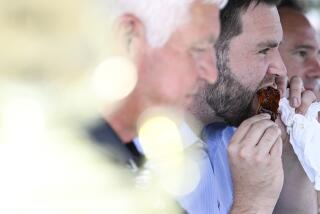Empty calories
- Share via
THE murky official history of organized competitive eating traces a convoluted intestinal path back to a Nathan’s Famous hot dog eating contest on Coney Island in 1916. There are many variations (mayonnaise, eggs, pancakes, pizza), but the concept has always been the same: Eat a lot very fast. Proponents call it a sport and argue that it’s not a joke. Others, like Ralph Nader, rail against it as a sign of malignant American consumerism. Now, two new books devote themselves to resolving this important dispute.
“Eat This Book: A Year of Gorging and Glory on the Competitive Eating Circuit,” by Ryan Nerz, approaches the scene from the inside. Nerz is a struggling Ivy League graduate and freelance journalist who, after initially failing as a writer, wisely decided to try acting. When that didn’t work out either, he got hired by the International Federation of Competitive Eating to play the role of carnival barker. With little preparation, he was shipped off to Louisiana to emcee a meat pie eating competition. It’s a funny premise for a book, but Nerz doesn’t make a particularly compelling narrator. He tells us too little about himself and thus gives us no reason to want to see him succeed.
Still, his deepening involvement in the IFOCE affords us a behind-the-scenes look at a bizarre competition. The mastermind of it all is a New York public relations executive named George Shea. Shea, whom Nerz calls a “gifted huckster,” is almost wholly responsible for turning eating into a spectator sport. Through much of the ‘90s, he worked the mike at self-produced eating contests in malls and buffets across the country. His ludicrously wonderful onstage spiels are what made it all work, because eating, it turns out, is just not very visually captivating. People simply cram food into their mouths over and over again. There’s not a lot to see, so to make the spectacle engaging, the emcee has to deliver a stand-up routine.
Nerz is at his best when he’s onstage, building on the material that Shea passed along to him. At the meat pie contest, he confides to the audience that one competitor has broken out in “the meat sweats, a lesser-known disorder in which protein enzymes mix with adrenaline to cause both delirium and an extremely malodorous form of sweat.” At a noodle eating contest in Ohio, he announces: “Never before in the history of this parking lot have the people of Columbus witnessed such greatness.” It’s funny, in the mock-serious way that professional wrestling is funny.
Unfortunately, Nerz has also adopted some of Shea’s hucksterism. He tries to convince the reader that competitive eating is a significant part of American culture and boasts about all the “media impressions” that he expects the IFOCE to garner. It starts to sound a lot like PR, and no wonder -- after the meat pie contest, Nerz became a full-time IFOCE employee, soon to be hailed as “Mini-George.”
Nerz refers to these contests as an “entertainment product” and appreciates eaters who have “fully embraced the WWF element of character development.” Eventually, he uses his journalism chops to spy for Shea on a rival eating league. This assignment could have been played for laughs (eating leagues have spies?), but Nerz wants competitive eating to be taken seriously and maintains a lofty, reportorial tone throughout. It’s tough to swallow.
Most of the real chewing is done by Jason Fagone, author of “Horsemen of the Esophagus: Competitive Eating and the Big Fat American Dream,” who covers a lot of the same events but from the audience or hovering around the periphery. Fagone, it appears, has been blacklisted by the IFOCE for referring, in magazine articles, to various competitors as “fat.” You wouldn’t think this would be an uncommon or unexpected observation, but, according to Fagone, Shea did not want his eaters to be regarded as fat freaks and warned IFOCE contestants not to talk to him.
If true, this was a mistake, because Fagone is the better writer and reporter. His language is crisp (of the stomach he notes that it lacks “the heft of the liver, the industriousness of the heart, the mystery of the pancreas, and the transplantability of the kidneys -- like other understated valiant things, cops and tollbooths and C-SPAN, the stomach’s glory is not aesthetic”), and his narrative is a pleasure to follow.
When eaters do agree to talk to him -- generally those who are already on the outs with Shea -- Fagone captures the details of their lives. He sits down in their living rooms, meets their kids, gets to the heart of their pursuit. What it comes down to is that, like everyone else, competitive eaters want to be special in some way. As one of them, with the improbable name of David “Coondog” O’Karma, remarks to Fagone: “To be up on stage shoveling food in your face beats everyday existence for most people.”
But Fagone also zeros in on the folly. Bill “El Wingador” Simmons, a chicken wing eating champ, admits that “Just throwin’ [stuff] down my gullet doesn’t make me anybody’s hero.” Simmons and O’Karma -- two middle-aged guys with burgeoning eating-related health problems -- are the focus of the first two-thirds of the book, and their stories are decidedly depressing. Both have passed the prime of their eating prowess, and they are tiring of the diarrhea and stomach pain associated with the competitions.
The last section focuses on a younger competitor, Tim “Eater X” Janus, but he too has been overshadowed by newer, more successful eaters, and he’s worried that Shea is going to stop inviting him to contests. All three teeter on the verge of quitting, and it leaves the reader with a sense of melancholy. What’s missing here is the joy that comes with winning. Champions invigorate and define their sport, but Fagone doesn’t get close enough to any of the winners to taste the thrill of victory.
That’s left to Nerz, who gets a lot of opportunities and squanders them. He tours the country with Sonya “The Black Widow” Thomas, a 105-pound woman who is generally acknowledged as the No. 1 American eater. The chapter documenting their travels reads like an annotated itinerary. And though Nerz clearly has a close relationship with George Shea, we never get a personal view of the man behind it all.
Ultimately, the reader is left wishing that someone with Fagone’s talent and Nerz’s access had chronicled the eating-contest circuit. Unfortunately, neither of these authors offers an all-you-can-eat feast, producing a distinct hunger best remedied by spooning quickly through a pint of Ben & Jerry’s.
More to Read
Sign up for our Book Club newsletter
Get the latest news, events and more from the Los Angeles Times Book Club, and help us get L.A. reading and talking.
You may occasionally receive promotional content from the Los Angeles Times.









